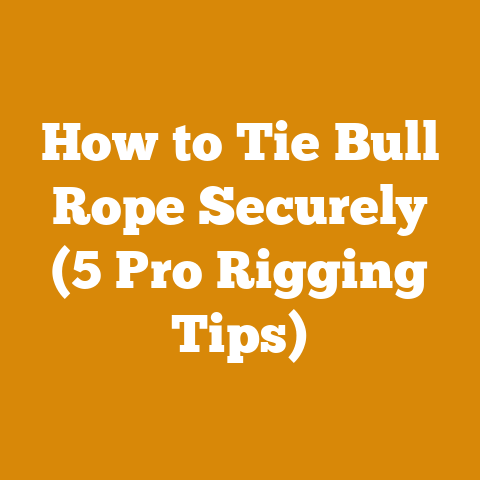Cost of Getting a Tree Cut Down (5 Pro Tips for Safe Logging)
Ever wondered what it really costs to have a tree cut down?
It’s more than just a guy with a chainsaw, that’s for sure.
I’ve spent years felling trees, from backyard maples to towering pines in the Pacific Northwest, and I’ve learned that understanding the true cost – and how to manage it – is crucial for both your wallet and your safety.
In this guide, I’ll pull back the curtain on the expenses involved, and I’ll share five pro tips to ensure your logging project is safe, efficient, and doesn’t break the bank.
The Real Cost of Tree Removal: Beyond the Initial Quote
The initial quote you receive for tree removal is just the tip of the iceberg.
Several factors influence the final price, and understanding them will empower you to negotiate effectively and avoid hidden costs.
Factors Influencing Tree Removal Costs
- Tree Size and Species: This is the big one.
A towering oak will cost significantly more to remove than a small ornamental cherry tree.
Hardwoods, generally, are denser and require more effort to cut and process, impacting labor costs.- Data Point: A 60-foot oak tree might cost $1,000 – $2,000 to remove, while a 20-foot cherry tree could be in the $300 – $700 range.
These costs are highly variable based on location and specific tree characteristics.
- Data Point: A 60-foot oak tree might cost $1,000 – $2,000 to remove, while a 20-foot cherry tree could be in the $300 – $700 range.
- Tree Location and Accessibility: Is the tree easily accessible, or is it nestled between your house and the power lines?
Difficult access means more time, specialized equipment (like cranes), and increased risk, all of which translate to higher costs. - Tree Health and Condition: A dead or diseased tree can be more dangerous to remove, requiring extra precautions and potentially specialized techniques.
The wood itself might be brittle and unpredictable. - Proximity to Hazards: Power lines, buildings, fences, and other obstacles significantly increase the complexity and risk of the job, driving up the price.
- Stump Removal: This is often an add-on service.
Grinding the stump below ground level requires specialized equipment and adds to the overall cost.- Data Point: Stump grinding can add $100 – $400 to the total cost, depending on the stump’s diameter and the depth of grinding.
- Debris Removal: Hauling away the tree debris – branches, trunk sections, and wood chips – is another factor.
You can often save money by handling this yourself, if you have the means. - Local Regulations and Permits: Some municipalities require permits for tree removal, especially for large or protected trees.
The cost of these permits needs to be factored in.- Example: In some areas, removing a tree with a diameter greater than 12 inches requires a permit, costing anywhere from $50 to $200.
Hidden Costs to Watch Out For
- Emergency Services: If a tree falls unexpectedly and causes damage, the cost can skyrocket.
Prevention is key. - Property Damage: A reputable tree service will have insurance, but accidents happen.
Make sure they are properly insured. - Unexpected Obstacles: Buried utilities, hidden structures, or unforeseen tree conditions can lead to additional charges.
A thorough site assessment is crucial.
5 Pro Tips for Safe and Cost-Effective Logging
Now, let’s dive into my top five tips for getting your tree cut down safely and without emptying your wallet.
Tip 1: The Power of a Detailed Site Assessment
Before you even think about calling a tree service, conduct your own detailed site assessment.
This will help you understand the scope of the job and communicate effectively with potential contractors.
- Identify Hazards: Note the location of power lines, buildings, fences, underground utilities (gas, water, sewer), and any other potential obstacles.
- Assess Tree Condition: Look for signs of disease, decay, or structural weaknesses.
Note the tree’s lean, branch structure, and overall health.- Technical Detail: Inspect for fungal fruiting bodies (mushrooms) on the trunk or roots, which can indicate internal decay.
Also, look for cracks, cavities, or excessive sap flow.
- Technical Detail: Inspect for fungal fruiting bodies (mushrooms) on the trunk or roots, which can indicate internal decay.
- Measure Tree Dimensions: Estimate the tree’s height and diameter.
This will help you get more accurate quotes.- Practical Tip: Use the “pencil trick” to estimate tree height.
Hold a pencil at arm’s length, aligning the tip with the top of the tree and your thumb with the base.
Turn the pencil sideways and measure the distance from your thumb to where the pencil tip now points.
This distance approximates the tree’s height.
- Practical Tip: Use the “pencil trick” to estimate tree height.
- Document Everything: Take photos and videos of the tree and its surroundings.
This will be invaluable when communicating with tree services.
Personal Story: I once had a client who failed to mention a buried septic tank near the base of a tree they wanted removed.
The tree service nearly drove their stump grinder right over it!
A detailed site assessment could have prevented this potentially disastrous situation.
Tip 2: Get Multiple Quotes and Ask the Right Questions
Don’t settle for the first quote you receive.
Get at least three different estimates from reputable tree services.
- Verify Credentials: Ensure the company is licensed, insured, and bonded.
Ask for proof of insurance. - Ask About Experience: How long have they been in business?
What is their experience with similar tree removal projects? - Inquire About Equipment: Do they have the necessary equipment for the job, including chainsaws, bucket trucks, cranes, and stump grinders?
- Clarify the Scope of Work: Make sure the quote clearly outlines all the services included, such as tree removal, stump grinding, debris removal, and site cleanup.
- Understand Payment Terms: What is the payment schedule? Do they require a deposit?
- Ask About Safety Procedures: How do they ensure the safety of their crew and your property?
- Don’t Be Afraid to Negotiate: Once you have multiple quotes, don’t hesitate to negotiate.
You might be surprised at how much you can save.
Key Questions to Ask:
- “What specific techniques will you use to remove the tree?”
- “How will you protect my property from damage?”
- “What is your plan for handling unexpected problems?”
- “Are you familiar with local tree removal regulations?”
- “What is your policy on handling wildlife that may be nesting in the tree?”
Tip 3: Prioritize Safety Above All Else
Tree removal is inherently dangerous. Don’t cut corners on safety.
- Hire Professionals: Unless you have extensive experience and the right equipment, leave tree removal to the professionals.
- Observe from a Safe Distance: Keep a safe distance from the work area while the tree is being removed.
- Wear Protective Gear: If you are assisting with the cleanup, wear appropriate protective gear, including a hard hat, safety glasses, gloves, and sturdy boots.
- Be Aware of Overhead Hazards: Watch out for falling branches and debris.
- Never Work Alone: Always have someone nearby in case of an emergency.
- Proper Chainsaw Use: If you are doing any cutting yourself (firewood processing after the tree is down, for example), always use a properly maintained chainsaw and follow all safety guidelines.
- Technical Detail: Chainsaw chain sharpness is critical.
A dull chain requires more force, increasing the risk of kickback.
Sharpen your chain regularly or have it professionally sharpened.
Aim for a raker depth of 0.025 – 0.030 inches for optimal cutting performance.
- Technical Detail: Chainsaw chain sharpness is critical.
- Emergency Plan: Have a plan in place in case of an accident.
Know the location of the nearest hospital and how to contact emergency services.
Safety Equipment Requirements (Minimum):
- Hard Hat: ANSI Z89.1 Type I or II rated
- Safety Glasses: ANSI Z87.1 rated
- Hearing Protection: NRR (Noise Reduction Rating) of at least 25 dB
- Gloves: Cut-resistant gloves for handling branches and debris
- Sturdy Boots: Steel-toed boots with good ankle support
- Chainsaw Chaps (if using a chainsaw): Rated to protect against chainsaw cuts
Tip 4: Understand Wood Utilization and Debris Removal Options
What happens to the tree after it’s cut down?
The answer to this question can significantly impact the overall cost.
- Firewood: If you have a fireplace or wood stove, consider keeping the wood for firewood.
This can save you money on heating costs and reduce the amount of debris that needs to be hauled away.- Technical Detail: Firewood needs to be seasoned (dried) for at least six months to reduce its moisture content to below 20%.
This ensures efficient burning and reduces creosote buildup in your chimney.
Aim for a moisture content of 15-20% for optimal performance.
- Technical Detail: Firewood needs to be seasoned (dried) for at least six months to reduce its moisture content to below 20%.
- Milling: If the tree is a valuable species like oak or maple, consider having it milled into lumber.
This can be a great way to obtain high-quality wood for woodworking projects. - Wood Chips: Wood chips can be used for landscaping, mulching, or composting.
- Debris Removal Services: If you don’t want to deal with the debris yourself, the tree service can haul it away.
Be sure to get a clear estimate of the debris removal costs. - Donation: Some organizations accept donated wood for community projects.
Firewood Drying Tolerances:
Case Study: I once helped a client remove a large oak tree from their property.
Instead of paying for debris removal, we had the tree milled into lumber.
The client used the lumber to build a beautiful deck, saving them thousands of dollars.
Tip 5: Proper Chainsaw Calibration and Maintenance
If you plan to process the wood yourself, proper chainsaw maintenance is paramount for safety and efficiency.
- Chain Tension: Ensure the chain is properly tensioned.
Too loose, and it can derail; too tight, and it can overheat and break.- Technical Detail: The chain should be able to be pulled away from the guide bar about 1/8 inch.
- Chain Sharpness: A sharp chain cuts smoothly and efficiently.
A dull chain requires more force and increases the risk of kickback. - Lubrication: Keep the chain and bar properly lubricated.
This reduces friction and wear.- Technical Detail: Use a high-quality bar and chain oil specifically designed for chainsaws.
Check the oil level regularly and refill as needed.
- Technical Detail: Use a high-quality bar and chain oil specifically designed for chainsaws.
- Air Filter: Clean the air filter regularly.
A dirty air filter can reduce engine performance and cause overheating. - Spark Plug: Inspect and replace the spark plug as needed.
- Carburetor Adjustment: If your chainsaw is not running properly, you may need to adjust the carburetor.
Consult your owner’s manual or take it to a qualified repair shop. - Regular Maintenance: Follow the manufacturer’s recommended maintenance schedule.
Chainsaw Calibration Standards:
- Idle Speed: Adjust to the manufacturer’s specification (typically around 2,500-3,000 RPM)
- High Speed: Adjust for optimal power without over-revving (consult owner’s manual)
- Chain Tension: 1/8 inch gap between chain and bar when pulled downwards
- Chain Sharpness: Consistent, even cutting edges on all teeth
Personal Story: I once neglected to properly maintain my chainsaw.
The chain was dull, and the air filter was clogged.
As a result, the chainsaw overheated and seized up, requiring expensive repairs.
Learn from my mistake!
Regular maintenance is essential.
Conclusion: Knowledge is Power (and Savings)
Getting a tree cut down can be a significant expense, but by understanding the factors that influence the cost and following these five pro tips, you can ensure a safe, efficient, and cost-effective logging project.
Remember, knowledge is power – and in this case, it can save you a lot of money and potential headaches.
So, do your research, get multiple quotes, prioritize safety, and don’t be afraid to ask questions.
Happy logging!






